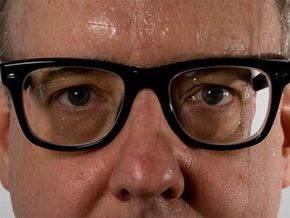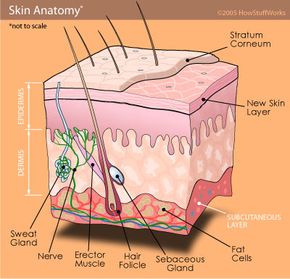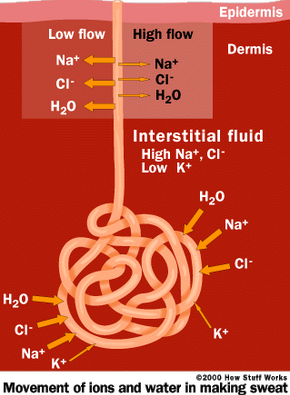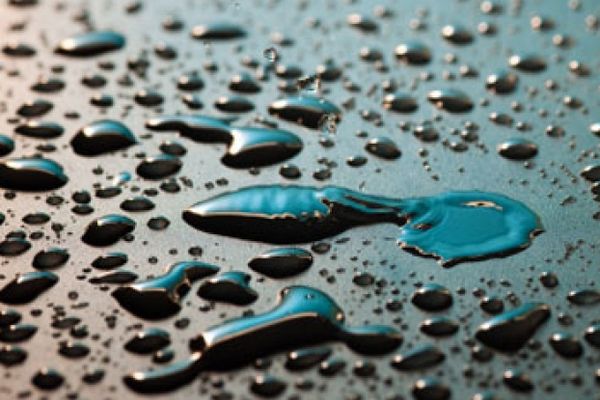When sweat evaporates from the surface of your skin, it removes excess heat and cools you. This is actually due to a neat principle in physics, which goes like this. To convert water from a liquid to a vapor, it takes a certain amount of heat called the heat of vaporization. This heat energy increases the speed of the water molecules so that they can escape into the air. For water, this value is 540 calories/gram or 2.26 x 106 joules/kilogram. So, if you can produce one liter of sweat, which is equal to 1000 g or 1 kg (density of water is 1 g/ml or 1 kg/l) in one hour, then 540,000 calories of heat can be removed from your body. This is an extreme example using the maximum amount of sweat that a person can make. Typically, all of the sweat does not evaporate, but rather runs off your skin. In addition, not all heat energy produced by the body is lost through sweat. Some is directly radiated from the skin to the air and some is lost through respiratory surfaces of the lungs.
A major factor that influences the rate of evaporation is the relative humidity of the air around you. If the air is humid, then it already has water vapor in it, probably near saturation, and cannot take any more. Therefore, sweat does not evaporate and cool your body as efficiently as when the air is dry.
Finally, when the water in the sweat evaporates, it leaves the salts (sodium, chloride and potassium) behind on your skin, which is why your skin tastes salty. The loss of excessive amounts of salt and water from your body can quickly dehydrate you, which can lead to circulatory problems, kidney failure and heat stroke. So, it is important to drink plenty of fluids when you exercise or are outside in high temperatures. Sports drinks contain some salts to replace those lost in the sweat.
Nervous or Scared?
As we mentioned earlier, sweating responds to your emotional state. So when you are nervous, anxious or afraid, there is an increase in sympathetic nerve activity in your body as well as an increase in epinephrine secretion from your adrenal gland. These substances act on your sweat glands, particularly those on the palms of your hand and your armpits, to make sweat. Thus, you feel a "cold" sweat. Also, the increased sympathetic nerve activity in the skin changes its electrical resistance, which is the basis of the galvanic skin response used in lie detector tests.
Excessive Sweating
Excessive sweating -- usually on the palms of the hand or the armpits -- that is not caused by emotional or physical activity is called diaphoresis or hyperhidrosis. It is often an embarrassing condition. The cause or causes are unknown, but the condition may be due to the following:
- hormonal imbalances (e.g., menopause in women)
- overactive thyroid gland (The thyroid hormone increases body metabolism and heat production.)
- certain foods and medications (e.g., coffee with its high amounts of caffeine)
- overactivity of the sympathetic nervous system
This condition can be treated by medications and surgical procedures.
For more information on sweat and related topics, check out the links on the next page.




